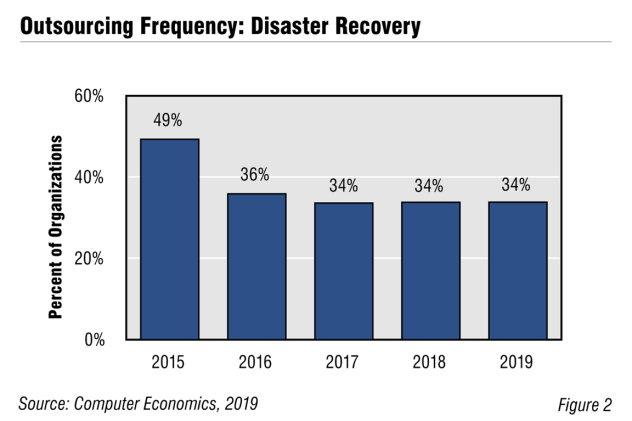In today’s economy, where businesses increasingly rely on the IT department for day-to-day operations, being able to recover from a disaster or system failure is more important than ever. Because of that reality, many IT organizations (though not as many as in the past) find value in disaster recovery outsourcing, where a service provider is responsible for off-site data storage, recovery data centers, or redundant systems.
After a significant drop in the number of companies choosing to outsource this function after 2015, the percentage has hit a plateau. As shown in Figure 2 from our full report, Disaster Recovery Outsourcing Trends and Customer Experience, the percentage of organizations outsourcing this function has remained steady at 34% the past three years. In 2015, it hit 49%. It appears that whatever drop was going to happen in this percentage has already happened, and we are at a new percentage of companies—about one-third. Several factors are responsible for this, including the desire to bring such a strategic function in-house and the perceived resilience and DR capabilities of cloud infrastructure.

Despite this new normal, disaster recovery is becoming more important—whether responsibility remains in house or delegated to a service provider. The amount of business transacted online continues to expand, even for traditional brick-and-mortar organizations, making the cost of downtime more expensive. Factories and distribution centers are increasingly automated, and operations can grind to a halt if a disaster strikes. A network outage can be disastrous for healthcare providers that increasingly rely on digital images and electronic medical records for patient care. Moreover, in some industries, such as banking, disaster recovery capabilities are mandated by law.
“There are many factors to consider and ways to save money when considering disaster recovery outsourcing,” said Tom Dunlap, director of research for Computer Economics, a research and consulting firm based in Irvine, Calif. “First, a local provider may be a better fit and able to deliver at a lower cost than a large IT services provider. Second, the market for these services is competitive, so price can be negotiated. Finally, disaster recovery as a service should be considered for at least some disaster recovery functions, as cloud providers can offer more of a pay-as-you-go model.”
Not all disaster recovery scenarios involve calamities such as hurricanes, floods, earthquakes, or terrorist attacks. Disruptions are more likely to involve public-grid power outages, network outages, transit failures, simple human error, or system failures. In these cases, organizations simply want employees to communicate effectively during temporary work disruptions. It is important that IT managers not lose sight of the more mundane incidents that can disrupt business operations.
To help IT executives understand their options, the full report analyzes the percentage of organizations outsourcing disaster recovery capabilities (frequency), the scope of work outsourced (level), and the change in the amount of work being outsourced (trend). We also present success rates for the cost and service experiences and show how these trends differ by organization size and sector. We also discuss the elements that every disaster recovery plan should contain.
This Research Byte is a brief overview of our report on this subject, Disaster Recovery Outsourcing Trends and Customer Experience. The full report is available at no charge for Avasant Research subscribers, or it may be purchased by non-subscribers directly from our website (click for pricing).

